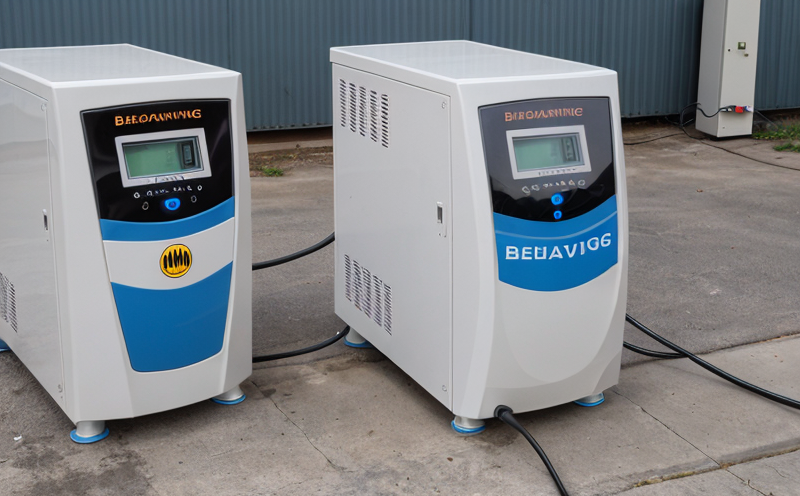IEEE 1188 Charging and Discharging Behavior Testing of VRLA Batteries
The IEEE Standard IEEE 1188-2012 provides a framework for the testing of valve-regulated lead-acid (VRLA) batteries. This standard is particularly relevant in sectors such as telecommunications, data centers, and uninterruptible power supplies where uninterrupted power supply is critical.
VRLA batteries are widely used due to their maintenance-free operation and long shelf life. However, the performance of these batteries can vary significantly under different charging and discharging conditions. The IEEE 1188-2012 standard specifies a comprehensive set of procedures for testing VRLA batteries to ensure they meet the required performance characteristics in real-world applications.
The testing protocol outlined in this standard is designed to assess how well a battery performs under both charging and discharging conditions. This includes evaluating the battery's capacity retention, voltage stability, and internal resistance over time. The test also helps identify potential weaknesses or defects that could lead to premature failure of the battery in critical applications.
During the testing process, batteries are subjected to various charge and discharge cycles under controlled environmental conditions. These conditions can include temperature variations, charging rates, and depth of discharge. The goal is to simulate real-world usage scenarios to provide a more accurate assessment of the battery's performance.
The IEEE 1188-2012 standard specifies detailed procedures for preparing the test specimens. This includes ensuring that the batteries are fully discharged before testing begins. The charging and discharging cycles are then performed according to predefined protocols, with close monitoring of key parameters such as voltage, current, and internal resistance.
The testing process is conducted using specialized equipment designed to meet the stringent requirements outlined in the standard. This includes precision measurement instruments capable of accurately recording all relevant data points. The collected data is analyzed thoroughly to determine whether the batteries meet the specified performance criteria.
Upon completion of the test, a comprehensive report is generated detailing the results of each cycle performed. This report provides valuable insights into the battery's charging and discharging behavior under various conditions. It also highlights any areas where improvement may be necessary to ensure optimal performance in real-world applications.
The IEEE 1188-2012 standard ensures that VRLA batteries undergo rigorous testing to guarantee their reliability and longevity. By adhering to these standards, manufacturers can produce high-quality batteries that meet the stringent requirements of critical power supply systems.
Why It Matters
The performance of valve-regulated lead-acid (VRLA) batteries is crucial for maintaining uninterrupted power supply in various sectors. These batteries are used extensively in telecommunications, data centers, uninterruptible power supplies, and other critical infrastructure where downtime can be costly or even catastrophic.
Understanding the charging and discharging behavior of VRLA batteries is essential for ensuring their reliability and longevity. The IEEE 1188-2012 standard provides a standardized approach to testing these batteries, allowing manufacturers and users to have confidence in the performance data provided.
By adhering to this standard, battery manufacturers can ensure that their products meet or exceed the required performance levels specified by industry regulations. This not only enhances customer satisfaction but also helps build trust within the market.
The results of IEEE 1188-2012 testing are valuable for quality managers and compliance officers who need to verify that batteries comply with relevant standards. It is also beneficial for R&D engineers looking to optimize battery design or improve manufacturing processes.
For procurement teams, knowing the performance characteristics of VRLA batteries tested according to IEEE 1188-2012 helps them make informed decisions when selecting suppliers and products. This ensures that the chosen batteries will perform reliably under expected operating conditions.
Why Choose This Test
The IEEE 1188-2012 standard offers several advantages for manufacturers, quality managers, compliance officers, R&D engineers, and procurement teams. By choosing to test VRLA batteries according to this standard, organizations can ensure that their products meet the highest industry standards.
One of the primary benefits is the ability to compare performance data across different manufacturers consistently. This ensures fairness in competitive bidding processes and helps establish a level playing field for all participants.
The rigorous testing procedures outlined in IEEE 1188-2012 provide greater confidence that batteries will perform reliably under various conditions. This reduces the risk of unexpected failures during critical operations, thereby minimizing downtime and associated costs.
Compliance with this standard also enhances brand reputation by demonstrating a commitment to quality and reliability. Customers appreciate products that have been rigorously tested and proven capable of meeting challenging performance requirements.
R&D engineers can use the results from IEEE 1188-2012 testing to identify areas for improvement in battery design or manufacturing processes. This information can be used to develop more efficient, durable, and cost-effective products.
For procurement teams, knowing that batteries have been tested according to this standard simplifies decision-making by providing objective data upon which purchasing decisions can be based.
Competitive Advantage and Market Impact
Adhering to the IEEE 1188-2012 standard for testing VRLA batteries offers significant competitive advantages in the marketplace. Organizations that adopt this approach demonstrate their commitment to quality, reliability, and performance excellence.
The rigorous testing process ensures that only high-quality products make it to market, giving consumers peace of mind about the performance and longevity of these essential components. This enhances brand reputation and customer trust, leading to increased sales and market share.
By meeting stringent industry standards like IEEE 1188-2012, manufacturers can differentiate themselves from competitors by offering products that consistently perform well under challenging conditions. This creates a strong competitive edge in the market.
The data generated through these tests provides valuable insights into battery performance characteristics, which can be used to improve future product offerings. This continuous improvement cycle helps maintain a leading position in the industry.
Moreover, compliance with this standard facilitates easier entry into international markets where strict regulations govern product quality and safety. It simplifies regulatory approval processes and reduces time-to-market for new products.





